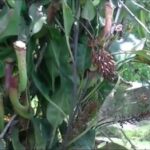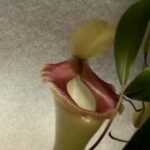As an Amazon Associate, this site earns commissions from qualifying purchases. For more details, click here.
Nepenthes albomarginata is probably best known for the white band on its pitchers which is used to lure termites. Native to Malaysia and Borneo, n. albomarginata can be classified as an easy to intermediate level tropical pitcher plant. It is not the easiest one to grow but not too difficult either. Follow this guide to learn its cultivation.
Nepenthes albomarginata prefers filtered bright lighting and at least 60% humidity. This lowland nepenthes grows fast in 70-85 F (21-29.4 C) temperature and must never be exposed to frost. It is ideal as an indoor houseplant.
Nepenthes Albomarginata Care Sheet
| Soil | 1:1 perlite and sphagnum moss |
| Water | Distilled, spring, purified or rainwater |
| Light | 6-8 hours partial light, indoor lighting is fine |
| Food | Small insects, freeze dried mealworms, fish pellets |
| Temperature | 70-85 F (21-29.4 C) |
| Humidity | 60% |
| Dormancy | Not required |
| Propagation | Leaf cuttings |
Soil
A 1:1 mix of perlite and sphagnum moss is well suited for nepenthes albomarginata. The soil should always be moist but not too damp. Never put fertilizer or compost in the media. Any type of garden soil for non-carnivorous plants should be avoided.
Most tropical pitcher plants use the same soil, including n. albomarginata. Peat moss and perlite are also good. Other materials like vermiculite and silica sand are often used with lowland nepenthes and they should work with n. albomarginata too.
Just like all carnivorous plants, n. albomarginata only grows in poor nutrient soil. The plant consumes insects because they contain the nutrients it requires. Even so, soil is still important for transporting water to the roots and serving as an anchor.
Pot Container
Not including the pitchers, nepenthes albomarginata ranges from 2 to 6 inches in diameter. You can use a 3-6 inch pot or hanging basket depending on how you want to display it.
If you are going to use a regular pot, set the plant on a sunny window. This should provide the right amount of sun without the sun directly hitting it.
If you are going to hang your pitcher plants outdoors, consider its position carefully. You want the plant to have access to the sun, but not too much the leaves gets burned.
Any type of pot material will do as long as long as it is not prone to mineral buildup. These are ideal indoor plants so the best place is on a windowsill. You can place the pot anywhere actually as long as the conditions are right. This applies not just to nepenthes albomarginata but to nepenthes maxima and other pitcher plants.
Most n. albomarginata are sold bare root and may or may not include a pot. If it does not have one, take note of its size so you can get an appropriately sized container. Once you have prepared the soil you can plant your nepenthes and water it according to the guidelines below.
Water
Use only low mineral purified water on nepenthes albomarginata. Water regularly so the soil is always damp. Watering from the top is preferred as the tray method could damage the roots. Use only purified water like Poland Spring Water for the best results.
If your nepenthes is healthy, its pitchers should have liquids. If not, increase humidity around the plant and look for signs of infestation (deformed leaves, not eating, leaves turn brown etc.). Do not fill the pitchers with water.
It is all right to put a small amount of water in the pitcher, but no more than an inch. Do this only during summer if your nepenthes is struggling. But otherwise it is better to let the plant produce its own liquids.
When watering from the top, spay freely all over the plant. Do not target the pitcher or soil, just let the water flow all around the plant.
Since n. albomarginata does not go through dormancy, you have to water regularly regardless of the season. Never use water from the faucet because it contains minerals that could damage the plant.
Light
Like n. rafflesiana and other pitcher plants, nepenthes albomarginata prefers partially filtered bright light. The light must be bright but also shaded. Find a sunny location but the plant should be in indirect light.
This setup is not hard. If your nepenthes is indoors, a brightly lit windowsill will do. The window itself provides light but partially filters it as well. If your plant is outdoors hanging from a basket, position it so the sun shines indirectly.
Take note that n. albomarginata needs bright light and warm temperatures. Limited light could slow its growth so make sure its environment is properly set up. If the plant is indoors you can use Aspect Luxury LED Grow Lights to simulate the effects of the sun. Somme variants may need time to adjust to grow lights so patience is needed.
If the temperature range is ideal (see following section) chances are your nepenthes is getting sufficient light. As long as the sun is not directly over it there should be no issues.
Temperature
Keep the plant in 70-85 F (21-29.4 C) during the day and no lower than 60 F (15.5 C) at night. Nepenthes albomarginata must be sheltered from frost and extreme heat. A warm zone is the best place to grow these lowland nepenthes, and you should be able to leave the plant outdoors the whole year.
If you have warm summers and cold winters, just bring the plant indoors before the temperature drops below 70 F in the day. If you live in a cold weather region, you can still grow n. albomarginata indoors in a terrarium or a heated room.
Healthy lowland nepenthes will tolerate higher temperatures than cold. Some species have been known to thrive in 90 degrees for example. If the other environment variables are ideal then your nepenthes will tolerate the heat.
Also worth noting is the temperature must remain warm at night. This can be a problem if you live ina cold region so consider using a heater or terrarium. If you do opt for a terrarium, you will need a light and heat source.
Humidity
One of the reasons why these pitcher plants thrive in warm temperature is if there is high humidity. Nepenthes albomarginata needs high humidity, at least 60%. The higher the humidity the better it is for the plant.
Humidity plays an important factor in pitcher plant health. High humidity enables n. albomarginata to survive high temperature and intense light. It also speeds up production of liquids for the pitchers.
If you think humidity is lacking, a humidifier or fogger is the solution. Because n. albomarginata are usually grown indoors, it is easier to use these devices. If your nepenthes pitcher is empty, the lack of humidity and water are the most likely reasons.
Nutrition and Feeding
To set things straight, pitcher plants do not eat insects for food. These plants make their own food as explained in this article. However, carnivorous plants still benefit from insects because they have nutrients lacking in the soil.
Nepenthes albomarginata eats crawling and flying insects including flies, gnats, ladybugs, crickets and others. If it is small enough to fall into the pitcher, the plant will try to eat it. If the bug is too large it might be able to escape though.
If your nepenthes is outdoors and you regularly see bugs in its pitchers, your plant is already well fed. But if it is indoors with no nutrient access, you should give it food – insects, fish food or freeze dried bloodworms – at least every two weeks.
Dormancy
Nepenthes albomarginata does not need dormancy. Most tropical pitcher plants bloom the entire year and so their environment must be stable.
The rule is simple: nepenthes albomarginata grows in warm temperature so you have to maintain that for the entire time. If the temperature drops below the optimum range, growth will slow and the plant could even perish.
Most grow their n. albomarginata indoors so outdoor weather is not a problem. Just make sure there is a heated area in your home during winter so the plant thrives.
Even though lowland nepenthes do not go through dormancy, you should still wait for winter to end before repotting. A lot of these plants produce new growth in spring, but before they do you can perform repotting, and later on propagation.

My fascination with carnivorous plants began many, many years ago with Venus Fly Traps. Now I am more than happy to impart what I know with other enthusiasts and those who are curious about meat eating plants.



